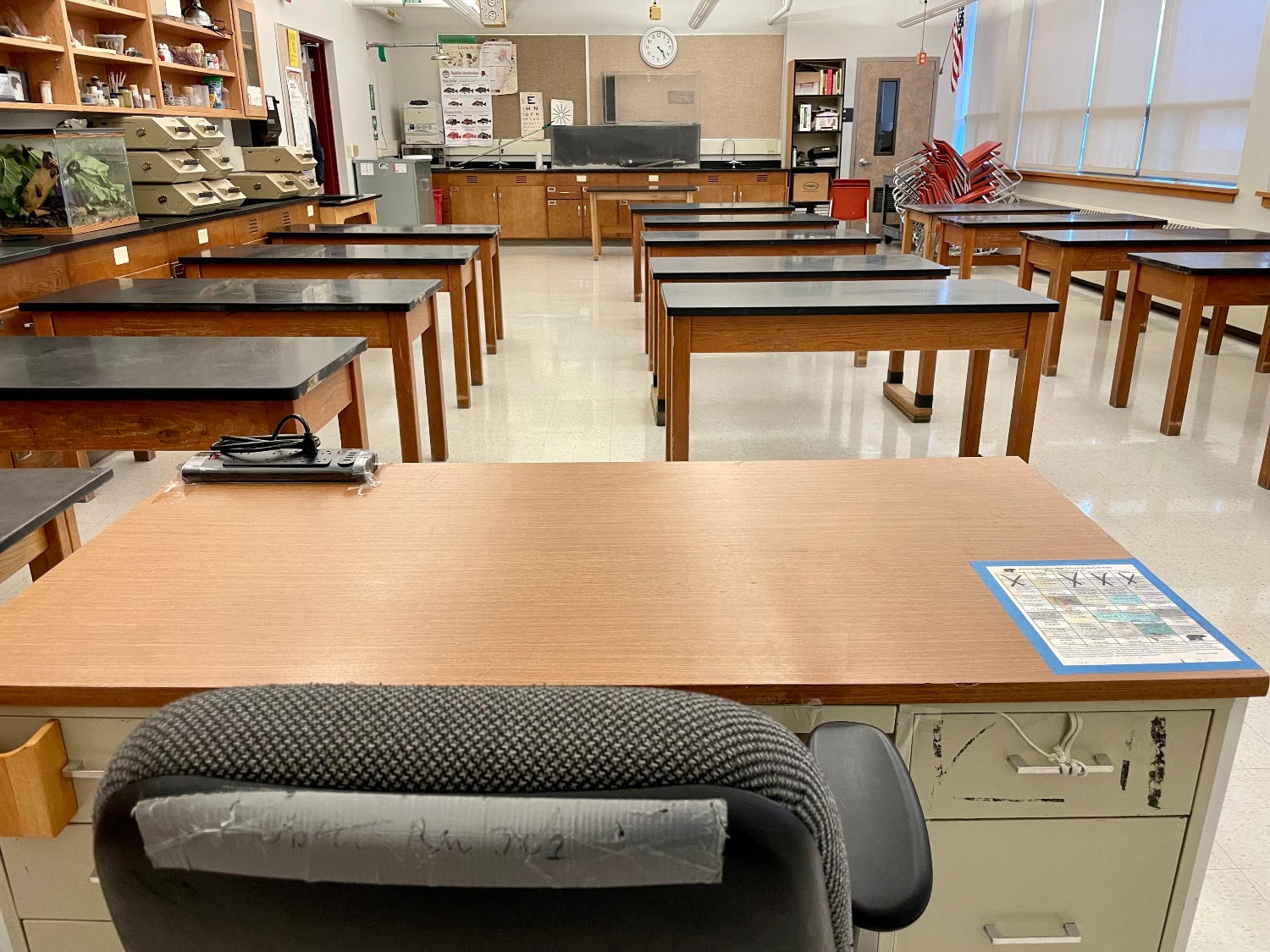
A dispute between Alaska’s education officials and their federal counterparts over whether the state spent pandemic relief equitably has had its first tangible consequence: the state must receive a federal OK before it can spend nearly $1 million in grants.
The United States Department of Education has put restrictions on the money in addition to labeling the state as “high risk” for receiving future grants because it says the state has not equitably distributed funds among its districts. State officials contest this assertion.
This disagreement has raised questions about whether Alaska schools will lose out on future grants.
Since last year, Alaska officials have pushed back against a federal warning that said the state underfunded certain school districts and failed to fully comply with requirements for spending $359 million in pandemic relief grants. The grant funds in question are from the American Recovery Plan Act, and were intended to stabilize schools after pandemic closures.
Federal officials have allowed Alaska to distribute that money. But in an update to the Alaska Board of Education and Early Development at its June meeting, state officials said the equity issue is unresolved and the department has already incurred some consequences as a result.
The restricted money is in an administrative account; the state education department needs to ask the federal government before it spends it.
Alaska Education Commissioner Deena Bishop told board members that the state used the account to pay the temporary employees who administered its grants.
“The consequence is only with the administrative fees at the state level,” she said at the meeting. She said the department does not have plans to spend that money.
One looming possibility that has legislators and district superintendents concerned is that the federal government could withhold future grant money from Alaska schools, or even take grant money back, but that has not yet happened.
Bishop sought to assure board members the dispute will not affect other federal grants, like the $425 million in federal grant money the state is set to receive on July 1. And she emphasized that it did not affect the pandemic relief funds.
“The actual ARPA funds that were meant for school districts have already been dispersed and are already used, and there’s not a problem with them,” she said.
Assistant Attorney General Susan Sonneborn said that if the federal government withheld money based on the “high-risk” designation, the state could file an administrative appeal.
The heart of the disagreement is over a new provision to pandemic-era education grants, called “maintenance of equity.” The idea behind it is that the federal government would give out huge grants, so long as states made sure that they were distributed fairly.
The intent was to make sure state education funding to historically underserved groups of students remained at pre-COVID-19 pandemic levels; maintenance of equity only applies to districts that serve high needs or high poverty populations.
Austin Reid, the National Conference of State Legislatures’ lead federal education policy analyst, said the maintenance of equity provision is “an unusual and, in some ways, extraordinary federal authority.” Typically, states have authority over how they fund education. Reid briefed legislators on the provision in April.
The maintenance of equity provision said that states are not allowed to reduce the amount of funding per student to certain school districts below the amount they received in 2019, the year directly preceding the pandemic. The covered districts include schools that serve high-poverty areas or high-needs students. This is where federal officials say Alaska has run afoul of their guidance; some districts got less state money in 2022 than they did in 2019.
Alaska has a complicated per pupil funding formula that was designed to maintain equity among the state’s students and schools. Bishop points to that formula when she counters the federal assessment.
She said Alaska’s per pupil funding formula follows the intent of the law — and if the state allocated less funding to certain districts that enrolled fewer students during the pandemic, it did so precisely because it used a formula the U.S Department of Education approved.
Reid said Alaska is not alone in that regard: Many states’ complex funding formulas do not align neatly with the federal maintenance of equity test, which is based only on a student’s income. He estimated that more than 40 states have struggled to meet the maintenance of equity requirements.
In an April presentation to the Senate Education Committee, Reid explained that there are three state education finance strategies that can cause them to not comply with the federal law: a per-student funding formula, a mechanism to equalize spending and a “hold harmless” provision, aimed at preventing districts from experiencing cuts in aid. Alaska employs all three strategies.
In Alaska’s case, officials say it is likely those mechanisms affected total per pupil funding as many students switched to home or correspondence school during the pandemic.
“For a state with an equalized per pupil funding formula, there was no way to know how to comply if simply maintaining funding and distribution in the same historical manner was insufficient,” he said.
Despite this, Alaska’s current dilemma is unique. Though many states have struggled with compliance, Alaska is the only state that has not resolved the issue.
Counteroffer
Federal officials say the state did not maintain equity over two years. The alleged inequity closest at hand is the 2022 fiscal year, for which they say the state owes the Kenai Peninsula Borough School District $5.48 million and Anchorage School District $6.4 million. To make up for 2023 shortfalls, federal officials say the Juneau, Anchorage, Kenai Peninsula and Fairbanks districts are owed a total of more than $5 million.
In a May letter, Bishop maintained the state did no wrong, but offered federal officials a compromise: DEED would ask the state Legislature to appropriate $327,015 for the Fairbanks North Star Borough School District. This amount is less than 2% of what the feds say all districts are owed.
“This amount represents the additional funds that would be owed to the district for FY2023 if the U.S. Department of Education were to prevail in its interpretation that MOEquity applies to Alaska notwithstanding the lack of a statewide funding cut, and also takes into account elements of Alaska’s state funding formula that distort MOEquity calculations,” she wrote.
State officials, including Bishop and Sonneborn, have noted that federal officials have changed the amount they say the state owes districts several times. In March, the total neared $30 million; federal officials reduced it to under $17 million. A spokesperson for U.S. DOE said that is because Alaska’s education department has submitted several different versions of its equity calculations.
Bishop’s correspondence with federal officials has repeatedly cited court cases where states had prevailed in funding arguments. The department did not address questions about whether or not it would pursue litigation against the federal government or why only the Fairbanks district was addressed in its compromise proposal.
Legislative response
The dispute is a concern for state legislators. The Senate majority caucus included $11.89 million in the operating budget for the upcoming fiscal year to allow the state to come into compliance with the federal government’s grant requirements and recover its good standing. The budget amount equals the total 2022 funding for Kenai Peninsula and Anchorage schools cited by the federal government. Alaska’s education officials did not mention this funding to their federal counterparts in the May letter that offered the compromise.
It remains to be seen whether the administration of Gov. Mike Dunleavy will approve or veto the money. The budget was transferred to Dunleavy’s office on June 5 and he must decide whether to sign or veto it by June 28.
Senate Education Committee Chair Löki Tobin, D-Anchorage, said her office has been in communication with federal officials who have said they can no longer accommodate Alaska’s noncompliance. She said federal officials gave no indication they would accept the agency’s compromise offer.
“It’s nice to see they’re still trying to find a resolution,” she said of the state’s education officials. “But I believe the U.S. Department of Education has been clear that there’s only one resolution option, and I do not see any potential court action deciding in our favor.”
Tobin said her main concern is that the “high-risk” status could make districts less competitive for any grant application, even from sources other than the federal government, because of the stigma. Many districts, such as the Ketchikan School District, use the state’s education department as their fiscal sponsor when applying for grants, she said.
“It’s again, one of those situations where the department is creating the crisis that could easily be avoided,” she said.
Tobin is a strong supporter of increasing support for schools to implement the Alaska Reads Act, which the administration has said can be funded through outside grants. She said the high-risk determination could complicate that, too. In her last conversation with federal officials, she said it was clear that continued noncompliance would result in increasing consequences.
“There is this belief that it’s just a gnat flying around our head, but I anticipate that over time it’s going to become a whole hive of bees, and we’re going to get stung repeatedly if we don’t move into compliance,” she said. “I’m not sure what the department’s goal is. I don’t understand what their intent is. We’ve asked multiple times for them to communicate with us, and they have not provided us any additional information.”
Commissioner Bishop repeatedly declined to brief the Senate’s Education Committee on the subject this spring, but Tobin said the department shared its latest correspondence with her office.
As of last week, Bishop said the U.S. Department of Education has not responded to the state’s request for a compromise. The federal department has said it does not have the authority to waive the grant requirements, which suggests it cannot make exceptions such as the compromise Alaska’s education department has proposed.















